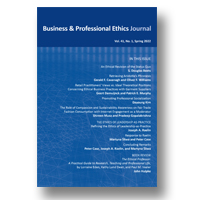|
|
|
1.
|
Business and Professional Ethics Journal:
Volume >
42 >
Issue: 2
Alma Acevedo
Ethical Leadership Insights from King Lear
abstract |
view |
rights & permissions
| cited by
Because of its appeal to the imagination, the intellect, the affections, and the will, literature has an invaluable role in the applied ethics education of business professionals and college students. This essay reaps ethics and ethical leadership insights from King Lear, while relishing its aesthetic value. By its side, core concepts underlying a proper understanding of applied ethics and hence ethical leadership are emphasized; particularly, the elements of human nature, moral agency and responsibility, the difference between morality and ethics, and an overview of virtue ethics and key intellectual and moral virtues. Stressing the connection between literature and moral philosophy, this essay shows how poetry can engagingly and compellingly transmit ethical concepts and values in leadership education.
|
|
|
|
|
|
|
2.
|
Business and Professional Ethics Journal:
Volume >
42 >
Issue: 2
Monika Ardelt, Bhavna Sharma
The Benefits of Wise Organizations for Employee Well-Being
abstract |
view |
rights & permissions
| cited by
Similar to personal wisdom, which is believed to be beneficial for individuals, others, and the larger community, wise organizations are likely to have a positive impact on employee well-being if their ultimate goal is to promote the common good. To test this hypothesis and create a wise organization index, the cognitive, reflective, and compassionate dimensions of the Three-Dimensional Wisdom Model were integrated with the psychological needs for competence, autonomy, and relatedness of Self-Determination Theory. The wise organization index consisted of the average ratings of ten scales by forty-seven to 1,930 employees in twenty-four organizations. Analyses of two-level hierarchical linear models showed that the positive association between the wisdom scores of twenty-four organizations and the well-being scores of 9130 employees was mediated by supervisor support and job fulfillment. The study suggests that employees who are treated well, feel well and fulfilled at work, which likely benefits the organization’s long-term success.
|
|
|
|
|
|
|
3.
|
Business and Professional Ethics Journal:
Volume >
42 >
Issue: 2
Rafael Cejudo
Corporate Responsibility for Arts and Culture:
Addressing the Impact of Globalization through I. M. Young’s "Social Connection Model"
abstract |
view |
rights & permissions
| cited by
Multinational companies (MNCs) in the creative and IT sectors play a decisive role in the production of cultural goods and in global cultural trends. Therefore, MNCs impinge on the right to take part in cultural life and must be held accountable for their impact on arts and culture on a global scale. As a dynamic and evolving process, open to alien influences, cultural life can be seen as a global social process, and as such is susceptible to structural injustices. I. M. Young’s social connection model is suggested to attribute a shared forward-looking responsibility to multinational companies and thus to assess corporate impacts on the quality of cultural life. The article highlights specific responsibilities for companies and proposes guidelines for judging their performance regarding arts and culture as a public good.
|
|
|
|
|
|
|
4.
|
Business and Professional Ethics Journal:
Volume >
42 >
Issue: 2
Constanza Guajardo
Exploitation:
Profit Versus Prices
abstract |
view |
rights & permissions
| cited by
This paper aims to offer a definition of excessive profit for cases of exploitation. Most of the literature that aims to identify cases of exploitation focus on determining a fixed price, and suggests that profit is excessive when individuals deviate from this price. More recently, Joe Horton has proposed an indifferent benchmark between transacting with a vulnerable party and not transacting with her. After arguing against the existing focus on prices, the paper proposes an alternative approach to exploitation which focuses on the profit made by the purported exploiter party. It suggests that profit is excessive when an agent makes more profit than the profit that a non-vulnerable purported exploiter would have made when transacting with a non-vulnerable second party. The focus on profit leads to the conclusion that different prices may be non-exploitative depending on the situation of the agents involved.
|
|
|
|
|
|
|
5.
|
Business and Professional Ethics Journal:
Volume >
42 >
Issue: 2
Marc S. Mentzer
Public Sector Corruption among the United States:
Exploring the Impact of Cultural Values
abstract |
view |
rights & permissions
| cited by
An adaptation of Hofstede’s classic model of culture was applied to the fifty US states, to examine the connection between states’ cultural values and the prevalence of public sector corruption. While the culture-corruption link has been widely studied at the country level, little research exists that examines this phenomenon at the level of the states. The ambivalence of the findings may be attributable to the challenge of disaggregating minor cultural differences among the states, in contrast to the enormous heterogeneity of the world’s countries.
|
|
|
|
|
|
|
6.
|
Business and Professional Ethics Journal:
Volume >
42 >
Issue: 2
Notes on Contributors
view |
rights & permissions
| cited by
|
|
|
|





